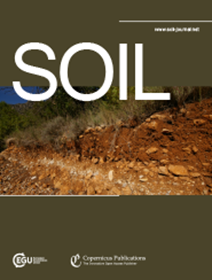揭示法国全国范围内土壤真菌多样性的生物地理模式和环境驱动因素
IF 5.8
2区 农林科学
Q1 SOIL SCIENCE
引用次数: 0
摘要
摘要真菌王国是地球上最多样化的王国之一,据估计多达 1 200 万种。然而,人们对它的了解仍然很少,目前描述的真菌只有 15 万种。鉴于真菌在生态系统功能中的重要生态作用,这些数字强调了研究不同生态系统类型中真菌多样性描述的重要性。在此,我们利用覆盖法国全境的法国土壤质量监测网络(沿系统网格采样的 2171 块土壤),在广泛的地理范围内探索了土壤真菌多样性的空间分布。通过针对 18S rDNA 基因的元条形码方法,直接从土壤 DNA 中评估了真菌的阿尔法多样性。全法国累计的真菌多样性包括 136 219 个可操作的分类单元(OTUs),也就是说,在仅占地球陆地表面 0.3% 的领土上,法国的真菌多样性约占全球土壤真菌多样性的 1%(基于 1 200 万个最大多样性估计值)。基于该数据集,绘制了第一张广泛的真菌阿尔法多样性地图,该地图显示,真菌丰富度(希尔多样性 0 级)在半径 231 千米的大型生物地理格局中呈现异质性和空间结构分布,优势真菌(希尔多样性 2 级)在半径 36 千米的较小格局中呈现异质性和空间结构分布。与其他环境参数一样,真菌多样性的空间分布(基于不同阶多样性的希尔数)主要受土壤特性和土地管理等当地因素的影响,同时也受气候条件等全球因素的影响。有趣的是,与森林土壤和葡萄园土壤相比,农田土壤的真菌多样性最高。作为补充,还计算了法国不同土地用途的土壤真菌 OTU 网络交互作用。结果显示,与森林相比,作物系统和草地的复杂性降低了 75%,而葡萄园系统的复杂性降低了 83%。总之,我们的研究表明,采用高空间分辨率方法进行全国范围的调查,对于深入研究土壤真菌多样性的空间分布和决定因素具有重要意义。我们的研究结果为更好地了解土壤真菌的 18S rDNA 基因生态学提供了新的见解,并通过提供具有代表性的土壤真菌专用资源库,提升了生物多样性保护政策的水平。本文章由计算机程序翻译,如有差异,请以英文原文为准。
Unraveling biogeographical patterns and environmental drivers of soil fungal diversity at the French national scale
Abstract. The fungal kingdom is among the most diversified kingdoms on Earth, with estimations of up to 12 million species. However, it remains poorly understood, with only 150 000 fungal species currently described. Given the major ecological role of fungi in ecosystem functioning, these numbers stress the importance of investigating fungal diversity description across different ecosystem types. Here, we explored the spatial distribution of the soil fungal diversity on a broad geographical scale, using the French Soil Quality Monitoring Network that covers the whole French territory (2171 soils sampled along a systematic grid). Fungal alpha diversity was assessed directly from soil DNA using a meta-barcoding approach by targeting the 18S rDNA gene. The total accumulated fungal diversity across France included 136 219 operational taxonomic units (OTUs), i.e., about 1 % of worldwide soil fungal diversity (based on a maximum diversity estimate of 12 million) for a territory representing only 0.3 % of the terrestrial surface on Earth. Based on this dataset, the first extensive map of fungal alpha diversity was drawn and showed a heterogeneous and spatially structured distribution in large biogeographical patterns of 231 km radius for richness (Hill diversity of order 0) and smaller patterns of 36 km radius for dominant fungi (Hill diversity of order 2). As related to other environmental parameters, the spatial distribution of fungal diversity (Hill numbers based on different orders of diversity) was mainly influenced by local filters such as soil characteristics and land management and also by global filters such as climate conditions with various relative influences. Interestingly, cropped soils exhibited the highest pool of fungal diversity relative to forest and vineyard soils. To complement this, soil fungal OTU network interactions were calculated for the different land uses across France. They varied hugely and showed a loss of 75 % of the complexity in crop systems and grasslands compared to forests and up to 83 % in vineyard systems. Overall, our study revealed that a nationwide survey with a high spatial-resolution approach is relevant for deeply investigating the spatial distribution and determinism of soil fungal diversity. Our findings provide novel insights for a better understanding of soil fungal ecology across the 18S rDNA gene and upgrade biodiversity conservation policies by supplying representative repositories dedicated to soil fungi.
求助全文
通过发布文献求助,成功后即可免费获取论文全文。
去求助
来源期刊

Soil
Agricultural and Biological Sciences-Soil Science
CiteScore
10.80
自引率
2.90%
发文量
44
审稿时长
30 weeks
期刊介绍:
SOIL is an international scientific journal dedicated to the publication and discussion of high-quality research in the field of soil system sciences.
SOIL is at the interface between the atmosphere, lithosphere, hydrosphere, and biosphere. SOIL publishes scientific research that contributes to understanding the soil system and its interaction with humans and the entire Earth system. The scope of the journal includes all topics that fall within the study of soil science as a discipline, with an emphasis on studies that integrate soil science with other sciences (hydrology, agronomy, socio-economics, health sciences, atmospheric sciences, etc.).
 求助内容:
求助内容: 应助结果提醒方式:
应助结果提醒方式:


